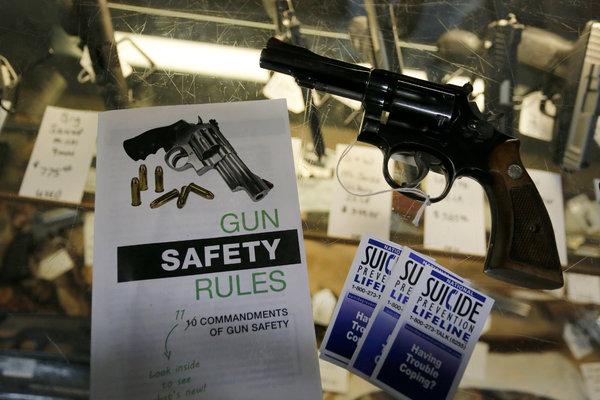
Safety and suicide prevention brochures next to guns for sale at a store in Montrose, Colo.CreditBrennan Linsley/Associated Press
Legislators and gun safety advocates often focus on how guns are purchased. But many lives could be saved, especially among children, if they looked more at how they are stored.
In the last decade, guns killed more than 14,000 American children. A startling number of those deaths — more than a third — were classified as suicides, and around 6 percent as accidents. Many more children were injured.
Nearly everyone agrees that children should not be able to buy guns, and no state lets them do so on their own. When children die by suicide in this way, it’s a result of being able to get hold of a gun that someone else already obtained — often legally.
How guns are stored matters. A study published this morning in JAMA Pediatrics has found that even a modest increase in owners who lock up their guns would pay off in an outsize drop in gun deaths.
Dr. Michael Monuteaux, an assistant professor of pediatrics at Harvard Medical School and an author of the study, said, “We need to communicate to parents that storing guns in a way that makes them inaccessible to children can reduce the number of children who die year after year, especially from suicide.”
In 2010, researchers examined who owned the firearms used in youth suicides. In cases where this could be determined, three-quarters of the time the owner was a parent, and for a further 7 percent it was some other relative.
In a 2005 study published in JAMA, researchers found that keeping guns locked and unloaded, and keeping ammunition locked and separate from guns, were significantly associated with lower levels of suicides and accidents among adolescents in gun-owning households. This held true for both handguns and long guns.
But such safety practices aren’t common. If a recent New York bill is signed into law, it will make the state one of just a handful with comprehensive gun storage laws to protect children.
Last year, a study based on a national survey in 2015 found that about one in three of all households in the United States owned at least one gun. Of those households with both guns and children at home, more than 20 percent reported storing them both loaded and unlocked — the least-safe way. An additional 50 percent stored them either loaded or unlocked.
This meant that about 7 percent of all children in the United States lived in a house in which at least one gun was stored in an unsafe manner. This was about twice the number reported in the previous national survey, published in 2002. Other research suggests that many people in gun-owning households, typically not the primary owner of the gun, think they are safely stored when they are not.
Critics of gun-storage laws say homeowners need to be able to act quickly if a criminal tries to enter a home. It’s not easy to measure how often guns are used in self-defense when someone attempts a break-in, but research suggests it’s a rare occurrence.
Suicides are less rare than self-defense shootings and, along with accidents, they are more likely in children who have parents who abuse alcohol. Studies have also found that children living with an adult who misuses alcohol were more likely to live in a house with a gun stored unsafely, and that heavy alcohol use was most common in those who store guns loaded and unlocked.
“We know from prior studies that children who live with alcohol-misusing adults are at a greater risk of suicide attempt, bullying victimization and perpetration, and unintentional injuries,” said Dr. Ali Rowhani-Rahbar, an associate professor of epidemiology at the University of Washington’s School of Public Health.
Critics also say safe storage laws are hard to enforce because of privacy concerns. As a model from today’s study in JAMA Pediatrics shows, though, even a modest intervention that motivates households to safely store guns could reduce youth firearm deaths by 6 percent to 32 percent.
Possible safety measures
Last year, in the journal Injury Prevention, Dr. Rowhani-Rahbar and other researchers reported on the results of two community-based firearm safety events in Washington State. They found that presenting people with information and offering to sell them trigger guards or lockboxes resulted in an increase of about 14 percent of households that stored all guns locked and 9 percent more that stored them unloaded.
In 2017, the Government Accountability Office reviewed 16 public or nonprofit programs that aimed to improve the storage of guns. It also reviewed studies of these programs. It found that distributing locks led to more safely stored guns. Few of these evaluations were rigorous, however. (Gun research, as with most things related to guns, is a politically divisive issue, and for many years research funding has been very low relative to other major causes of death.)
Policy can make a difference, too. In 2004, a study examined how laws that focused on the sale of guns affected the suicide rates of children, compared with laws mandating safe storage of firearms. They found that between 1976 and 2001, minimum-age purchase laws and possession-age laws had no effect on adolescent suicide rates. Laws preventing children’s access to guns, on the other hand, were associated with significant reductions of suicides by guns, even when reductions were not seen in suicides by other methods.
About two-thirds of gun deaths in the United States are suicides, and given political stalemates over gun rights, it seems an area in which policymakers could be more productive. Safer storage of guns, especially in households with children, might make more of a difference than many legislative and advocacy efforts that get more attention.

